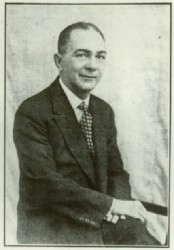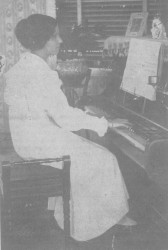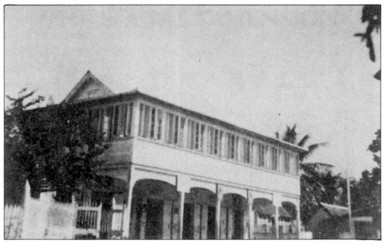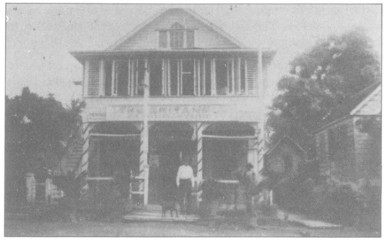This article was published in Stabroek News ‘Arts on Sunday’ on May 9, 1999 having been reprinted from The Portuguese of Guyana: A Study in Culture and Conflict by Prof Menezes.
By Mary Noel Menezes, RSM.
It was not too long after the Madeiran emigrants had begun to put down their roots in British Guiana that their inherent love for drama surfaced and found expression on the stage. From the record it seemed that formal Portuguese drama made its appearance in Demerara when a group of Portuguese amateurs presented a dramatic performance in aid of the Girls’ Orphanage in April 1854. Here again was a legacy from Madeira where a number of performances, both dramatic and musical, was staged for charity.

Cultural presentations before a large audience of the Portuguese community in British Guiana were often produced in aid of the Church, the Catholic Church, to which the Portuguese were loyal adherents. To help raise funds for the building of Meadow Bank Church “a very lively and dramatic [sic] and Musical Entertainment by Portuguese Amateurs” comprising popular musical selections and one-act comedians was given in the Philarmonic Hall at the end of November 1875. In the 1880s when the need for a new organ for Sacred Heart RC Church, Main Street, was discussed, the Portuguese Amateur group again rose to the occasion and produced a comedy in two Acts: Intrigad no Bairro.
In the last decade of the nineteenth century the Portuguese Amateur Dramatic Club was at the forefront of dramatic presentation in the colony. The newspapers of the day, both English and Portuguese were replete with lengthy, detailed descriptions of dramatic recitals and plays performed by Portuguese artistes whose names became household words. The fact that these dramatic recitals and plays were executed in Portuguese underscored the fact of the continuing. knowledge of the language among the Portuguese community in British Guiana well into the twentieth century. It was obvious that the Portuguese still wished to hold on to this medium of communication and the hallmark of their culture. Yet one must not conclude that the audiences at the Portuguese plays consisted only of the Portuguese-speaking community. Drama, especially comedy, transcended language, and there were non-Portuguese who graced the performances, enjoying the action even though not understanding the language.
On 17 April 1888 the Portuguese Amateur Dramatic Club presented three comedies in the Philarmonic Hall: Travessuras de Cupido, Uma Aposta and Os Estroinas. A well-filled house enjoyed the comedies to such an extent that they requested another entertainment of a similar kind. Thus in June the Dramatic Club again made its appearance on stage performing the comedy, Os Filhos de Adao to a large audience. At the same time the Georgetown Amateur Dramatic Club presented Richard III, Sc. IV, Act 4 which the press noted was poorly appreciated. It seemed that the Guianese audience preferred comic songs and farce to tragedy. The Portuguese Amateur Dramatic Club, most probably sensing the mood of the society, produced a series of comedies. It might well have divined the heart of the comedy which “is never the gaiety of things… it is the groan made gay.” Comedy indeed stresses the common bond, seeing man as a social animal, “gently mocking him for his ultimate unimportance.” Thus, comedy spoke to the Madeirenses who, far away from their island home, needed the cohesion of the common bond who, in those early years of settling in an alien land, were made to feel so strongly their unimportance.
Possibly the theatre was one of the means by which the Madeirans came to terms with life. Their penchant for farcical comedy “with its absurd situations and exaggeration of character” softened the harsh realities of life.

For centuries dramatists have been conscious of “the almost magical quality of songs within drama,” and the Portuguese dramatic presentations expressed this consciousness with their incorporation of choruses and dances.
There was no dearth of dramatic or musical talent among the Portuguese. This talent was nurtured among children who gave as many fine performances as did the adults. The schools were, as they continued to be in later years, training grounds for potential artistes both in drama and in music. The children of the Portuguese Catholic School, Main Street, produced a spectacular drama entitled: Um Naufragis nas Costas da Bretanha. The Daily Chronicle enthusiastically observed:
“The principal characters [were] enacted by lads and lasses with remarkable mimetic power and some spoke their lines with intuitive elocutionary talent. One little fellow was an especial favourite as an amiable bravado being wonderfully well ‘made up’ with a tawny beard and adopting a swaggering gait with perfect ease.”
The performance, staged at the Philarmonic Hall, was hailed as “a great success” and another successful performance was repeated a month later. The last decade of the nineteenth century was marked by a number of Portuguese dramatic and musical performances, most of them comedies at which the Portuguese Amateurs excelled. It seemed they were bent on ending the century with laughter and not with tears.
In May 1894, although the Portuguese Amateurs
presented a stirring drama, Scenes do Brazil at the Assembly Rooms, it was followed by two short pieces, one a comedy and the other a comedietta, Choro no Rio, and Os dios Estrionas. The comedy, Choro no Rio, was acclaimed the piece de resistance of the evening’s entertainment because of the excellent presentation and the high standard of the acting, especially of the artistes, Messrs Fernandes and Dias and Miss Jardim. The press hoped that the Portuguese Amateurs would continue to promote “such highly enjoyable entertainments oftener.” A month later the group complied with a Recita Dramatica, also held at the Assembly Rooms ‒ a presentation comprising of three one-act comedies and a comic scene. The names of Messrs Luis Martins, FC Fernandes, J Silvano, C De Freitas and the Misses dos Santos and Jardim, the well-known and leading artistes among the Portuguese Amateurs, received the plaudits of the audience and the press for their spirited performances.
A noteworthy feature was the ability of the actors and actresses to give convincing and humorous renditions which illustrate the lighter side of the Portuguese character. While some writers considered them sober with a tendency to melancholy, others have commented on the propensity of the Portuguese for laughter and jokes, “a humour that can be pricked to irony and truth.”

On auspicious occasions in the life of the Portuguese community gala performances were produced. On the anniversary of the Restoration of Portugal, on 1st December 1640, the Portuguese marked the occasion with a Comedy-Drama: in three Acts and four Scenes with a cast of more than fifty persons. The Portuguese newspaper Chronica Seminal, advertised it as “a remarkable production, the best that has yet been produced in Demerara.” But nothing was to equal the glorious commemoration of the Fourth Centenary of the discovery of the Cape route to India by the famous Portuguese navigator, Vasco da Gama. A rash of Church celebrations, rounds of concerts and plays and parades made 1898 a memorable year for the Portuguese.
The decorations of the Portuguese business premises and residences were so elaborate and lavish that it was correctly noted that “the festivities were carried out with all the pomp and brilliancy which characterise Lusitanian functions.”
Into the twentieth century the plays went on. In 1901 a “fine and beautiful play,” obviously an operetta, O Conde de Monte Cristo, as it was accompanied by a large orchestra, was produced by the Portuguese Amateurs, evincing great praise. The following year, the ladies were again in the forefront when they performed an opera, Snow White and the Seven Dwarfs and a “cleverly produced play,” Gunpowder Tea, in aid of the Plaisance Mission.

As Styan wrote: “Play-going is an art. It demands an active enthusiasm to join in the act of creation, the skill to interpret stage action and the discipline of an artist to fashion the play in the mind.” The Portuguese certainly enjoyed this art form to the hilt and brought to it all the elements of the art ‒ the vocal and aesthetics skills, costume designing and making, the building of sets, a confidence in themselves and a sensitivity to their audience.
In their love of comedy they walked in a long and great tradition of Grecian and Shakespearian theatre with its mixture of tragedy and comedy, as well as that of the commedia dell’arte of sixteenth and seventeenth century Italy and France.
Were they aware that “within comedy there is always despair, a despair of ever finding a right ending except by artifice and magic”?





